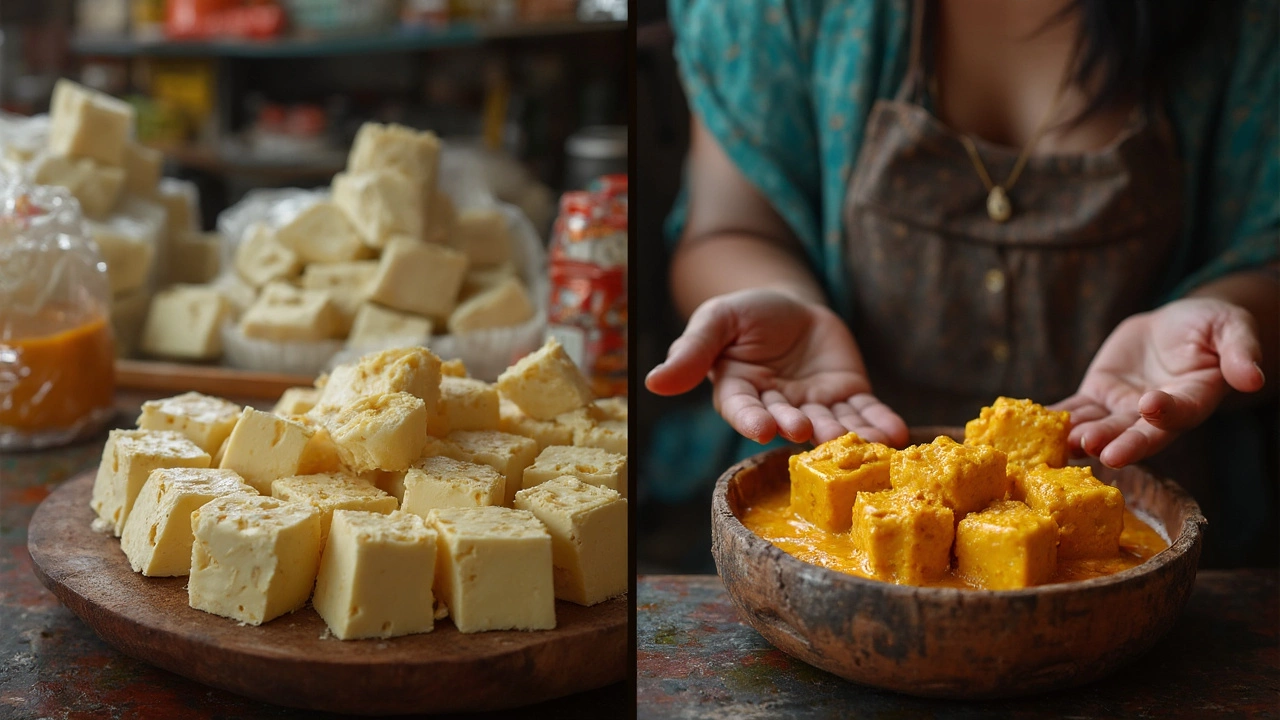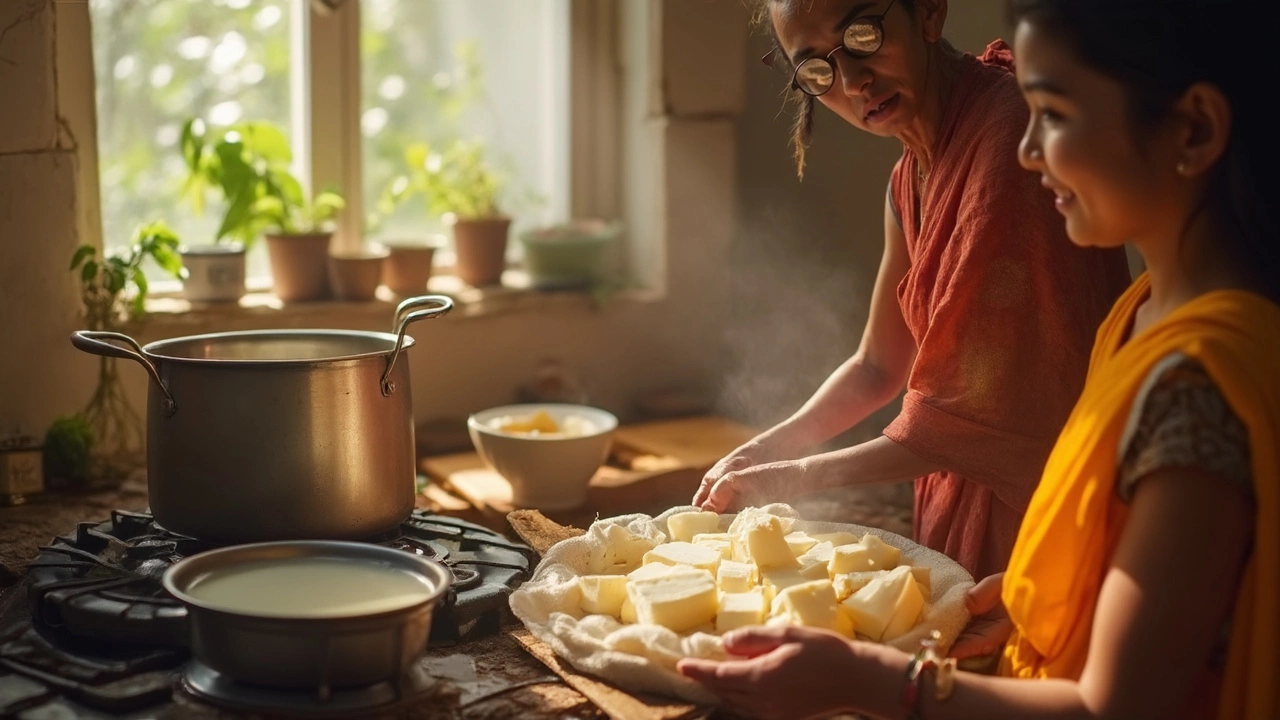The first time you bite into store-bought paneer after making it at home, the difference is a shock. Homemade paneer is usually soft, fluffy, and soaks up gravy like a sponge. Meanwhile, the blocks from the store can feel rubbery, dry, and sometimes even squeaky between your teeth. You’re not imagining things—it really is different.
The key reason is how store-bought paneer is made. Factories want a product that lasts on shelves and can hold its shape after transport, so they press it hard and sometimes use extra acids or stabilizers. That makes it firmer, and honestly, a bit sad for your curry. When you make paneer at home, you control the pressing and usually use simple ingredients, so it turns out much softer.
If you’ve ever struggled to cube store-bought paneer without it cracking, you’ve already hit on the problem. But there are ways to soften it again—like soaking it in hot water for ten minutes before adding it to your dish. It won’t make it as tender as homemade, but it helps a lot.
Getting restaurant-quality, pillowy paneer isn’t some secret trick—it's just about the milk, the acid, and not rushing the process. Once you’ve made paneer at home, you’ll see it isn’t magic. It’s just basic science and a little bit of patience.
- The Science Behind Paneer Texture
- How Factories Make Store-Bought Paneer
- Secrets to Soft Paneer at Home
- Tips for Fixing Hard Paneer
The Science Behind Paneer Texture
If you want to know why paneer feels so different depending on where you get it, it comes down to one word: protein. Paneer gets its texture from proteins in milk, mainly casein, which clump together when you add an acid like lemon juice or vinegar. This process is called curdling, and the way you handle the curds makes all the difference.
The amount of pressure and the length of time you press the curds both matter a lot. Factories press paneer longer and harder, so the cubes come out firm and compact, while homemade paneer usually gets less pressure and feels much softer. Let’s break down what really happens:
- When you press curds hard, more whey (the watery part) gets pushed out. Less whey means a drier, tougher paneer.
- If you don’t press much, paneer stays wet and squishy, soaking up flavors better in curries and gravies.
- The acid you pick also changes things. Vinegar makes slightly firmer paneer than lemon, and citric acid gives the most rubbery cubes.
There’s also the milk quality. Full-fat whole milk makes richer, softer paneer. Skim milk or low-fat milk gives you a chalky, crumbly texture no matter what.
Here’s a quick comparison:
| Factor | Softer Paneer | Harder Paneer |
|---|---|---|
| Milk Type | Whole milk | Low-fat milk |
| Acid Used | Lemon juice | Citric acid |
| Pressing Pressure | Light | Heavy |
| Pressing Time | 15-30 minutes | 1+ hour |
Why are these differences so big? It’s really all about how tightly you pack those proteins. The more they’re squished together, the firmer and sometimes even chewy your paneer gets. Once you know these small details, you can start tweaking recipes to fit exactly what you want on your plate.
How Factories Make Store-Bought Paneer
It’s easy to blame store-bought paneer for being so stubborn, but the real culprit is the industrial setup. Factories churn out tons of paneer a day, so speed and shelf life matter more than taste. This means tweaks in both ingredients and method. Most commercial brands use high-heat pasteurized milk, which is less creamy and gives a firmer curd. For large batches, acids like citric acid or even lactic acid powder stand in for good old lemon juice or vinegar. It’s all about getting the job done—fast.
The pressing step is what really seals the deal. Paneer blocks are pressed hard, usually using heavy machinery, to squeeze out every bit of whey. One food technologist summed it up like this:
“Commercial paneer is pressed to a standard moisture level of about 50%, almost half the water content of fresh, homemade paneer. This makes it firm enough to hold up in transit and slicing, but also much less soft.”
Some plants take it further, adding stabilizers like calcium chloride to help the curds stay tight and bouncy. A few brands also pasteurize again after packaging. All that handling means the final product is way less delicate than what you make at home.
| Step | Commercial Process |
|---|---|
| Milk source | High-heat pasteurized, often from mixed dairy sources |
| Coagulation | Chemical acids (citric/lactic acid) |
| Pressing | Heavy mechanical pressure to paneer blocks |
| Storage | Vacuum-sealed, sometimes pasteurized again |
| Moisture content | About 50% (homemade is 60%-70%) |
The upside? This means you can keep a block of store-bought paneer in the fridge for a couple of weeks without it falling apart. The downside is that texture trade-off. You get sturdiness, but it loses that soft, melt-in-your-mouth feel people love in homemade versions.

Secrets to Soft Paneer at Home
If you want soft, melt-in-the-mouth paneer at home, it’s less complicated than you think. A few tweaks in your process make all the difference. The first game-changer is milk. Always go for full-fat or whole milk—skimmed milk just won’t cut it if you want that creamy, spongy texture. The fat helps bind everything together and stops the paneer from getting dry and rubbery.
Next up is the acid you use to split the milk. Lemon juice, vinegar, or even sour yogurt work, but lemon juice is the go-to for most home cooks. Just make sure you add the acid slowly, stirring gently. If you dump it all in at once or stir too hard, you might end up with tough, grainy curds.
The real secret is in how you press it. If you want your paneer super soft, don’t overload it with weight. Just press it enough to hold its shape—usually something light like a pot filled with water or a couple of plates stacked up. Leave it like that for 10 to 20 minutes tops. Any longer, and you risk squeezing out too much moisture, which turns your paneer into something more like the store-bought kind.
Water matters too. After the curds separate from the whey, a gentle rinse with cold water washes away any lingering acidity. This step makes a real difference: it keeps your paneer milder and helps the texture stay tender, not chewy.
Summing it up, here’s what to do for soft paneer at home:
- Use whole milk (don’t try to save calories here!)
- Add acid bit by bit while stirring gently
- Press lightly and don’t overdo the weight or time
- Rinse the curds with cold water right after draining
After this, wrap the paneer in a cloth, chill it in the fridge for 30 minutes, and then cut into cubes. That’s it. Once you try homemade, you’ll realize just how much better it is than supermarket blocks.
Tips for Fixing Hard Paneer
Got a block of rock-hard paneer sitting in your fridge? You're not stuck with it. There are a bunch of easy fixes to bring back that soft, creamy texture. It takes just a few minutes and maybe a small tweak in your cooking routine.
Paneer gets hard because it's pressed too much or loses moisture. The fix often comes down to adding back some water and gentle heat. Here's what you can do:
- Soak in Hot Water: Cut your paneer into cubes and drop them into a bowl of hot (not boiling) water for about 10-15 minutes. Drain before cooking. This is what most Indian restaurants do before tossing paneer into curry—it softens it instantly.
- Steam It: Pop the cubes in a steamer basket over simmering water for 5 minutes. This works especially well if you’re short on time since it warms and loosens up the texture fast.
- Add It at the End: Don’t cook paneer for too long. Let the curry cook, then add the paneer in at the very end. Simmer for just a minute or two—enough to let it soak in some flavor but not enough to get chewy.
- Use Creamy Ingredients: Making dishes like palak paneer? Add a splash of cream or a bit of yogurt. The extra fat helps soften the cubes as they simmer.
Here’s a quick table showing which hack works best for each problem:
| Paneer Problem | Best Fix | Quick Tip |
|---|---|---|
| Dry and crumbly | Soak in hot water | 10-15 minutes in hot water makes a big difference |
| Rubbery texture | Don’t overcook | Add paneer at the end and don’t boil |
| Tasteless | Soak in salted or spiced water | Add salt or spices to soaking water for extra flavor |
| Too firm | Steam or gentle simmer in sauce | 5 minutes steaming works wonders |
If you're meal prepping, you can soak and then store paneer covered in the fridge with a little water. This keeps it soft for days. And if you want that extra pillowy feel, make your own at home. Once you start, you’ll spot store-bought paneer from a mile away!
